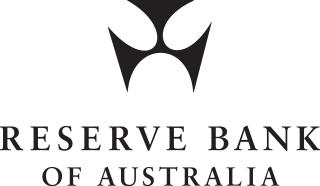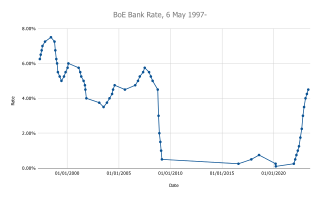Related Research Articles

The Federal Reserve System is the central banking system of the United States. It was created on December 23, 1913, with the enactment of the Federal Reserve Act, after a series of financial panics led to the desire for central control of the monetary system in order to alleviate financial crises. Over the years, events such as the Great Depression in the 1930s and the Great Recession during the 2000s have led to the expansion of the roles and responsibilities of the Federal Reserve System.

The Reserve Bank of India, abbreviated as RBI, is India's central bank and regulatory body responsible for regulation of the Indian banking system. It is under the ownership of Ministry of Finance, Government of India. It is responsible for the control, issue and maintaining supply of the Indian rupee. It also manages the country's main payment systems and works to promote its economic development. Bharatiya Reserve Bank Note Mudran (BRBNM) is a specialised division of RBI through which it prints and mints Indian currency notes (INR) in two of its currency printing presses located in Mysore and Salboni. The RBI, along with the Indian Banks' Association, established the National Payments Corporation of India to promote and regulate the payment and settlement systems in India. Deposit Insurance and Credit Guarantee Corporation was established by RBI as one of its specialized division for the purpose of providing insurance of deposits and guaranteeing of credit facilities to all Indian banks.

The Reserve Bank of Australia (RBA) is Australia's central bank and banknote issuing authority. It has had this role since 14 January 1960, when the Reserve Bank Act 1959 removed the central banking functions from the Commonwealth Bank.
The Federal Open Market Committee (FOMC) is a committee within the Federal Reserve System that is charged under United States law with overseeing the nation's open market operations. This Federal Reserve committee makes key decisions about interest rates and the growth of the United States money supply. Under the terms of the original Federal Reserve Act, each of the Federal Reserve banks was authorized to buy and sell in the open market bonds and short term obligations of the United States Government, bank acceptances, cable transfers, and bills of exchange. Hence, the reserve banks were at times bidding against each other in the open market. In 1922, an informal committee was established to execute purchases and sales. The Banking Act of 1933 formed an official FOMC.
In macroeconomics, an open market operation (OMO) is an activity by a central bank to give liquidity in its currency to a bank or a group of banks. The central bank can either buy or sell government bonds in the open market or, in what is now mostly the preferred solution, enter into a repo or secured lending transaction with a commercial bank: the central bank gives the money as a deposit for a defined period and synchronously takes an eligible asset as collateral.

The Central Bank of the Republic of Türkiye (CBRT) is the central bank of Turkey. Its responsibilities include conducting monetary and exchange rate policy, managing international reserves of Turkey, as well as printing and issuing banknotes, and establishing, maintaining and regulating payment systems in the country.

The Bank of Korea is the central bank of the Republic of Korea and issuer of Korean Republic won. It was established on 12 June 1950 in Seoul, South Korea.

The Monetary Policy Committee (MPC) is a committee of the Bank of England, which meets for three and a half days, eight times a year, to decide the official interest rate in the United Kingdom.

The Czech National Bank, is the central bank and financial market supervisor in the Czech Republic, headquartered in Prague. It is a member of the European System of Central Banks. It was established on 1 January 1993 from the division of the State Bank of Czechoslovakia as part of the process of dissolution of Czechoslovakia, together with the National Bank of Slovakia.
Bank rate, also known as discount rate in American English, is the rate of interest which a central bank charges on its loans and advances to a commercial bank. The bank rate is known by a number of different terms depending on the country, and has changed over time in some countries as the mechanisms used to manage the rate have changed.
The interbank lending market is a market in which banks lend funds to one another for a specified term. Most interbank loans are for maturities of one week or less, the majority being overnight. Such loans are made at the interbank rate. A sharp decline in transaction volume in this market was a major contributing factor to the collapse of several financial institutions during the financial crisis of 2007–2008.
From the 1991 India economic crisis to its status of third largest economy in the world by 2011, India has grown significantly in terms of economic development, so has its banking sector. During this period, recognizing the evolving needs of the sector, the Finance Ministry of the Government of India set up various committees with the task of analyzing India's banking sector and recommending legislation and regulations to make it more effective, competitive and efficient.
Monetary policy is the process by which the monetary authority of a country, generally central bank controls the supply of money in the economy. In India, the central monetary authority is the Reserve Bank of India (RBI).
Liquidity adjustment facility (LAF) is a monetary policy which allows banks to borrow money through repurchase agreements (REPO).

Deepak Mohanty is an economist. He holds the post of Chairperson of India’s pension regulator, Pension Fund Regulatory and Development Authority(PFRDA). He was Chief Economic Advisor, Federation of Indian Chambers of Commerce and Industry (FICCI) and was an independent Director on a few companies’ Boards. Prior to that, Dr. Mohanty was Whole Time Member, PFRDA.

Urjit Patel is an Indian economist, who formerly served as the 24th Governor of the Reserve Bank of India and also Deputy Governor of Reserve Bank of India, looking after monetary policy, economic research, financial markets, statistics and information management. He resigned from his post on 10 December 2018, being the first RBI governor to state personal reasons as a driving factor for resigning.

Shaktikanta Das is serving as the current & 25th governor of the Reserve Bank of India (RBI). He was earlier a member of the Fifteenth Finance Commission and India's Sherpa to the G20. Das is a retired 1980 batch Indian Administrative Service (IAS) officer of Tamil Nadu cadre.
Michael Debabrata Patra is an Indian economist and central banker. A career Reserve Bank of India officer, he is currently serving as one its four deputy governors.
References
- 1 2 "Monetary Policy Committee constitution under the Reserve Bank of India Act, 1934 notified". pib.nic.in. Retrieved 24 June 2017.
- 1 2 "Government initiates process to constitute Monetary Policy Committee (MPC) under the Reserve Bank of India Act, 1934". Press Bureau of India. 27 June 2016. Retrieved 1 December 2019.
- ↑ ET Bureau (6 August 2016). "India adopts inflation target of 4% for next five years under monetary policy framework". The Economic Times. Retrieved 24 June 2017.
- ↑ "Reserve Bank of India - Function Wise Monetary". www.rbi.org.in. Retrieved 17 September 2019.
- ↑ Reporter, B. S. (24 July 2015). "No veto power for RBI governor in deciding interest rates, says draft code". Business Standard India. Retrieved 24 June 2017.
- ↑ "Newly appointed deputy governor to look after RBI's monetary policy division". Livemint . Mumbai: Vivek Khanna. Press Trust of India. 15 January 2020. Retrieved 16 January 2020.
- ↑ "595th Meeting of Central Board of the Reserve Bank of India". Reserve Bank of India.
- ↑ "MPC members to get Rs. 1.5 lakh per meet, must disclose assets". The Hindu. Retrieved 24 July 2017.